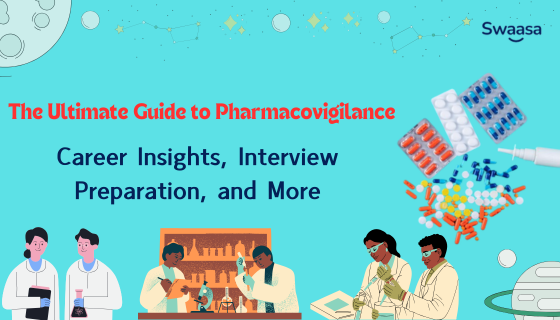
The Ultimate Guide to Pharmacovigilance: Career Insights, Interview Preparation, and More

21-Oct-2024
The Ultimate Guide to Pharmacovigilance: Career Insights, Interview Preparation, and More
Introduction to Pharmacovigilance
Pharmacovigilance is a crucial component of the pharmaceutical industry, dedicated to the monitoring and evaluation of the safety of medications post-marketing. With the increasing complexity of drug development and the variety of patient responses to medications, the need for effective pharmacovigilance practices has never been more essential. This guide aims to provide a detailed understanding of pharmacovigilance, the career opportunities it offers, the skills required, and effective preparation strategies for interviews.
What is Pharmacovigilance?
Pharmacovigilance can be defined as the science and activities related to the detection, assessment, understanding, and prevention of adverse effects or any other drug-related problems. It plays a vital role in enhancing patient safety and ensuring that the benefits of a drug outweigh its risks.
Historical Context
The concept of pharmacovigilance has evolved significantly over the years. Historically, adverse drug reactions (ADRs) were often overlooked, leading to serious consequences for patients. Notable cases such as the thalidomide tragedy in the 1960s highlighted the urgent need for a structured approach to drug safety. This led to the establishment of pharmacovigilance systems worldwide, enabling healthcare professionals to report and analyze adverse events associated with drug use.
Importance of Pharmacovigilance
- Patient Safety: The primary goal of pharmacovigilance is to improve patient safety by monitoring and evaluating the risks associated with drug therapy.
- Regulatory Compliance: Regulatory authorities, including the FDA (Food and Drug Administration) in the United States and the EMA (European Medicines Agency) in Europe, require pharmaceutical companies to have robust pharmacovigilance systems in place to comply with legal requirements.
- Data Collection and Analysis: Pharmacovigilance involves the collection of data on adverse drug reactions from various sources, including clinical trials, spontaneous reporting, and electronic health records. This data is analyzed to identify patterns and potential safety signals.
- Risk Management: Pharmacovigilance plays a crucial role in risk management strategies, helping to mitigate potential risks associated with drug use. This may involve updating labeling information, issuing warnings, or even withdrawing a drug from the market.
- Enhancing Drug Development: Insights gained from pharmacovigilance can inform the development of safer and more effective medications, ultimately benefiting both patients and pharmaceutical companies.

Career Opportunities in Pharmacovigilance
The field of pharmacovigilance offers diverse career paths that cater to various skill sets and backgrounds. Below are some of the most common roles in this area:
1. Pharmacovigilance Associate
Role Overview: Pharmacovigilance associates are responsible for monitoring and reporting adverse drug reactions. They collect and analyze data, ensuring compliance with regulatory requirements.
Responsibilities:
- Review and process adverse event reports.
- Collaborate with healthcare professionals to gather necessary information.
- Maintain and update pharmacovigilance databases.
Salary Expectation: Entry-level positions typically offer salaries ranging from ₹3 to ₹5 lakhs per annum (LPA).
2. Drug Safety Associate
Role Overview: Drug safety associates focus on evaluating the safety profiles of medications and conducting risk assessments.
Responsibilities:
- Conduct signal detection and risk management activities.
- Analyze clinical data for safety evaluations.
- Prepare reports for regulatory submission.
Salary Expectation: Mid-level positions range from ₹6 to ₹10 LPA, while senior roles can command salaries upwards of ₹12 LPA.
3. Pharmacovigilance Scientist
Role Overview: Pharmacovigilance scientists are experts who conduct in-depth analyses of adverse events and provide recommendations for risk management.
Responsibilities:
- Perform complex data analyses using statistical tools.
- Lead safety signal detection activities.
- Develop and implement risk minimization strategies.
Salary Expectation: Entry-level salaries start around ₹5 LPA, while experienced professionals can earn between ₹10 to ₹20 LPA.
4. Clinical Research Associate
Role Overview: Clinical research associates oversee clinical trials and ensure that pharmacovigilance practices are integrated into the study protocols.
Responsibilities:
- Monitor compliance with clinical trial protocols.
- Review and assess safety data collected during trials.
- Collaborate with clinical teams to address safety concerns.
Salary Expectation: Entry-level positions start at around ₹4 LPA, with experienced roles earning up to ₹15 LPA.
5. Medical Reviewer
Role Overview: Medical reviewers are responsible for evaluating clinical data and providing expert opinions on drug safety and efficacy.
Responsibilities:
- Review clinical trial data and safety reports.
- Assess the clinical significance of adverse events.
- Provide recommendations for regulatory submissions.
Salary Expectation: Salaries for medical reviewers typically range from ₹8 to ₹15 LPA, depending on experience.
Skills Required for a Successful Career in Pharmacovigilance
To excel in pharmacovigilance, candidates must possess a unique combination of technical, analytical, and interpersonal skills. Here are some of the essential skills needed:
1. Analytical Skills
Analytical skills are vital for interpreting complex data and identifying trends in adverse events. Professionals in pharmacovigilance must be able to evaluate large datasets, detect signals, and make informed decisions based on their analyses.
2. Attention to Detail
Given the critical nature of drug safety, a high level of attention to detail is essential. Pharmacovigilance professionals must accurately document adverse events, ensuring that all relevant information is captured and reported in compliance with regulatory guidelines.
3. Communication Skills
Strong communication skills are crucial for effectively conveying findings to various stakeholders, including regulatory authorities, healthcare professionals, and internal teams. Pharmacovigilance professionals must be able to present complex information in a clear and concise manner.
4. Technical Proficiency
Familiarity with pharmacovigilance databases and software tools is necessary for managing and analyzing safety data. Proficiency in statistical analysis software, such as SAS or R, is also advantageous.
5. Regulatory Knowledge
A solid understanding of the regulatory framework governing pharmacovigilance is essential. Professionals should be familiar with ICH-GCP (International Council for Harmonisation - Good Clinical Practice) guidelines and regional regulations set by agencies like the FDA and EMA.
6. Problem-Solving Skills
Pharmacovigilance professionals often encounter complex safety issues that require innovative solutions. The ability to think critically and approach problems systematically is essential for success in this field.
7. Collaboration and Teamwork
Pharmacovigilance involves working closely with cross-functional teams, including clinical research, regulatory affairs, and medical affairs. Strong teamwork skills are necessary for effective collaboration and information sharing.

Common Pharmacovigilance Interview Questions
When preparing for a pharmacovigilance interview, it’s important to anticipate the types of questions you may encounter. Here are some common interview questions along with tips for crafting effective responses:
General Questions:
1Q. What is your understanding of pharmacovigilance?
Ans: Provide a clear and concise definition of pharmacovigilance and emphasize its importance in ensuring patient safety and regulatory compliance.
2Q. Can you name the main regulatory authorities involved in pharmacovigilance?
Ans: Mention key regulatory bodies such as the FDA, EMA, WHO, and local agencies, and briefly explain their roles in pharmacovigilance.
3Q. Describe the process of adverse event reporting.
Ans: Outline the steps from identifying an adverse event to reporting it to regulatory authorities, including the roles of healthcare professionals and pharmacovigilance teams.
Technical Questions:
4Q. What are the differences between serious and non-serious adverse events?
Ans: Define serious adverse events (SAEs) and non-serious adverse events (non-SAEs) and provide examples to illustrate the differences.
5Q. How do you perform a benefit-risk assessment?
Ans: Explain the methodology for evaluating the overall therapeutic benefit against the risks associated with a drug, including the factors considered in the assessment.
6Q. What is the role of signal detection in pharmacovigilance?
Ans: Discuss the importance of identifying safety signals that may indicate potential safety issues with a drug and the methods used for signal detection.
Behavioral Questions:
7Q. Can you describe a challenging situation you faced and how you resolved it?
Ans: Use the STAR (Situation, Task, Action, Result) method to structure your response and highlight your problem-solving skills.
8Q. How do you keep yourself updated with the latest developments in pharmacovigilance?
Ans: Mention relevant journals, online courses, conferences, and professional organizations that you follow to stay informed.
9Q. Why are you interested in pursuing a career in pharmacovigilance?
Ans: Share your motivations for entering the field and highlight any relevant experiences or education that have shaped your interest.
Freshers Questions:
10Q. What motivated you to choose pharmacovigilance as your career path?
Ans: Discuss your passion for patient safety and interest in the pharmaceutical industry.
11Q. Can you explain the primary responsibilities of a Pharmacovigilance Associate?
Ans: Outline the key tasks associated with the role, such as data collection, reporting, and compliance.
12Q. What skills do you think are critical for success in pharmacovigilance?
Ans: Highlight the essential skills discussed earlier, emphasizing your strengths and how they relate to the role.
Interview Preparation Tips:
Preparing for a pharmacovigilance interview requires a strategic approach. Here are some effective preparation tips to help you succeed:
1. Research the Company
Understand the company's products, values, and recent developments in pharmacovigilance. Familiarize yourself with their pipeline and any relevant news articles to demonstrate your interest and knowledge during the interview.
2. Review Regulatory Guidelines
Brush up on key regulatory guidelines related to pharmacovigilance, including ICH guidelines and local regulations. Being well-versed in these guidelines will help you answer technical questions confidently.
3. Practice Mock Interviews
Conduct mock interviews with a friend or mentor to practice your responses to common questions. This will help you gain confidence and improve your communication skills.
4. Prepare Your Questions
Have a list of insightful questions ready to ask the interviewer about the company's pharmacovigilance practices, career growth opportunities, and team dynamics. This demonstrates your enthusiasm and engagement.
5. Stay Calm and Confident
During the interview, take a moment to gather your thoughts before answering questions. Stay calm and confident, showcasing your passion for pharmacovigilance and your willingness to learn.
Career Growth and Advancement
Pharmacovigilance offers significant career growth potential for dedicated professionals. Here are some pathways for advancement in this field:
1. Specialization
Pharmacovigilance professionals can choose to specialize in areas such as risk management, regulatory affairs, or signal detection. Specialization can enhance your expertise and open up new career opportunities.
2. Leadership Roles
With experience, pharmacovigilance professionals can advance into leadership positions, such as Pharmacovigilance Manager or Director of Drug Safety. These roles involve overseeing teams and strategic decision-making.
3. Transition to Related Fields
Many pharmacovigilance professionals transition to related fields such as clinical research, regulatory affairs, or medical affairs, broadening their skill sets and career options.
4. Continuous Education
Pursuing further education, such as a Master’s degree or specialized certifications in pharmacovigilance or clinical research, can enhance your credentials and increase your marketability.
Salary Expectations in Pharmacovigilance
Salary expectations in pharmacovigilance can vary widely based on factors such as location, experience, and specific roles. Here’s a general overview of salary ranges in India:
- Pharmacovigilance Associate: ₹3 to ₹5 LPA (Entry-level)
- Drug Safety Associate: ₹6 to ₹10 LPA (Mid-level)
- Pharmacovigilance Scientist: ₹10 to ₹20 LPA (Experienced)
- Clinical Research Associate: ₹4 to ₹15 LPA (Varies by experience)
- Medical Reviewer: ₹8 to ₹15 LPA (Experienced)
Conclusion:
Pharmacovigilance is an essential field dedicated to ensuring the safety and efficacy of medications, making it a rewarding career choice for individuals passionate about patient safety. With diverse career opportunities, strong demand for skilled professionals, and significant growth potential, pharmacovigilance offers a promising path in the pharmaceutical industry.
By understanding the roles, skills required, interview preparation strategies, and salary expectations outlined in this guide, aspiring pharmacovigilance professionals can confidently pursue their career goals and contribute to enhancing patient safety worldwide.

AUTHOR

Related Jobs


